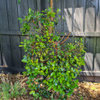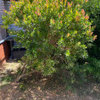Cadagi Tree
The Cadagi Tree (Corymbia torreliana)
This rainforest tree from North Queensland was used extensively in the 70Âs and 80Âs as a fast growing attractive shade tree in South East Queensland. It has an attractive shape and broad fury leaves. New leaves commence as red tips which make it pleasant to look at. The large flowers open in November, and appear to be well visited by the Native Bees. It is a valuable tree as far as food is concerned.
The Cadagi is one of these trees that causes a problem in the environment. Many councils along the east coast of Australia have listed the species as an undesirable noxious weed.
Although they are a very fast growing shade tree, probably the hardiest in your paddock and it was one of the most extensively planted shade trees in South East Queensland they are creating havoc for our native stingless bees.
Humans weren't the only forms of wildlife to go crazy for these trees. Our native bees also found them irresistible and this is where the problem lies.
To Bee or not to Bee
After pollination, the seedpods of the Cadagi develop and begin to open in early January and continue to mature until the end of February. This is a serious period of time for native bees. The bees collect the resin that spills from the seeds and mix it with their own native bee wax to be used as nest building and sealing material.
The bees become obsessed with the collection of resin but the problem lies with the resin being attached to the seed, translating to thousands of seeds being carried home by the bees. The determined little bee can be seen carrying two seeds home on their back legs which is an extraordinary feat considering each seed is approximately 1½ millimeters in diameter.
So with this process we have created 3 major problems.
Firstly a Clogged Front Door
There are literally thousands of seeds carried home. The inside for the box is lined with multiple layers of seeds. At the entrance of the nest, there are so many seeds, that the entrance may become completely clogged. A clogged up entrance may prevent air movement and cause overheating, and possible death of the nest. Obviously the bees cannot get in or out either.
Overheating and Collapse
The multiple layers of seed continue to exude resin that is in such large quantities that the fumes on a hot day may kill the colony.
Obsession with Seeds
From observation, the bees will continue to collect excessive seeds and resin during this traumatic period. Unfortunately they forget to clean up or guard the hive leaving it susceptible to one of its great enemies, the native fly.
And just in case any of us are left wondering how this 'natural' event could occur. The native bees and the Cadagi do not naturally occur together. We have brought the tree to the bees.
If that isn't enough to convince any would be planters keep in mind that the Cadagi is also a pest hosting tree which attracts Monolepta beetles and beware of parking your vehicle under...





Wooroonooran
gardenlen
Rose_Qld
Wooroonooran
gardenlen
artiew
trish_g
Wooroonooran
greg1958Original Author
gardenlen
trish_g
sweeney
Keith-WinterHaven-FL